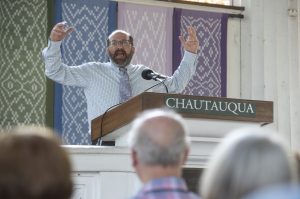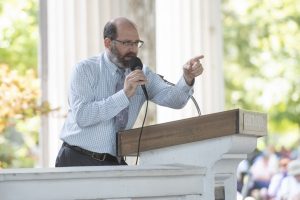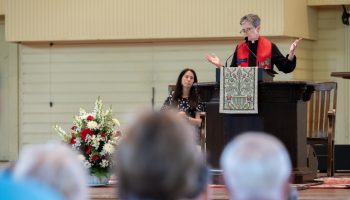
Change is possible. Though no one sees real change happen overnight, it does happen over time, and it is vital for people if they want a better quality of life. Adam Jortner said the Burned-over District, what he also referred to as “the Reform,” was full of movements that created important changes for Americans.
“These movements … are built by ordinary Americans who … wanted to help because they felt like belief in Jesus Christ demanded it,” said Jortner, an author, scholar of early American history and Goodwin-Philpott Professor of History at Auburn University. “Trying not to live for themselves, but for other people, … the reform movement took those cries and they built on it and they built temperance and abolition and women’s suffrage, and they did it politically, religiously and socially, and they fought town by town, street by street, house by house.”
Jortner, also the author of Blood from the Sky: A Political History of American Miracles, gave his lecture, “How the Burned-over District Changed America,” Thursday in the Hall of Philosophy, concluding the Week Five interfaith theme: “Chautauqua: Rising from the Ashes of the Burned-Over District.”
The Burned-over District was a place-based movement that started in Western New York and reached into Massachusetts, and it became known for religious fervor and revivals in the 1820s, Jortner said.
“A revival is a time and a place where a faith community can gather for prayer and for sermons, where members have an opportunity to commit themselves to the faith or to recommit themselves to the faith if they were born into it, or to have total strangers come and commit themselves to their faith,” Jortner said.
Jortner relates the temperance moment to the progression of the women’s suffrage moment.
— The Chautauquan Daily (@chqdaily) July 25, 2019
One man, Charles Finney — who would eventually become one of the most well-known revivalists and a remarkably famous preacher — gave up his professions as a lawyer and school teacher to travel around Upstate New York and preach, Jortner said. And, as he traveled around, Finney developed an idea. While other ministers believed that only God could cause revivals and put a spark in a sinner’s soul — and if there was no spark, the person was hopeless — Finney believed that to be “hogwash,” Jortner said.
“There are things you can do; religion is a thing for man to do,” Jortner said. “(Finney) writes, ‘It’s a human effort. We’re only up to God. You wouldn’t need a preacher. There are things you can do.’ ”
Finney developed instructions to create a revival, create a way to inspire sinners to come to Jesus Christ. And, Finney’s revivals among Presbyterians, Baptists and Methodists would be the most prominent, because those religious traditions were ones with local organizations, state organizations and national organizations.
With such powerful religious traditions coming to his revivals, Finney was able to share his organizational model with the people joining his movement.
“Not everybody liked this,” Jortner said. “A fellow Evangelist complained to Finney that revivals are fast becoming with this sort of trade to be worked at so many hours a day.”
What was particularly interesting about this movement Finney led was how political it seemed. Holding meetings, circulating handbills, taking up the front pages of newspapers — these were all things Finney viewed as political, and they were also how he believed revivalists were going to excite and attract others.
Men in the movement took these ideas with them when they went to preach and create revivals in other places. The women, on the other hand, used Finney’s model to organize, preaching in their own way about what a life lived for Christ demands: moral behavior and an end to moral abominations.
Finney’s model was used as a political movement, and women in the movement began to inspire change in this movement, beginning with stopping mail delivery on Sundays. As early as 1810, Jortner said, mail was delivered on Sunday, and women believed that Sunday was the Lord’s.

Over 900 petitions were sent to the United States Congress between 1828 and 1831, Jortner said. It failed, but that wouldn’t stop petitions for another campaign in 1836 against American slavery.
“Eventually, the house had to pass a gag rule to prevent (the petitions) from being read and declared that the very subject of slavery could not be discussed on the floor of the U.S. Congress,” Jortner said. “Now, that sounds like a big loss. It is actually an important victory because what abolitionists are able to do at that point is to turn around to the northern white public and say, ‘Hey, look at this. They won’t even let us talk about slavery.’ ”
This argument would gain a lot of support, eventually leading many to support Abraham Lincoln in the Civil War. This is vital, Jortner said, because white Americans in the North would have otherwise been content with ignoring slavery since they didn’t have to see it. However, because their own rights — rights to be heard — were threatened, white Americans in the North called for change.
Another movement that arose from the Reform, Jortner said, was the temperance movement. In 1825, Americans consumed 7 gallons of hard liquor a year, per capita, Jortner said.
“After the American Revolution, Americans began drinking much harder alcohol … deliberately drinking to excess,” Jortner said. “Why? In the words of one historian, ‘because whiskey won the American revolution just as surely as the Patriots.’ ”
At first, temperance reformers unsuccessfully tried fighting alcohol consumption with confrontation. Jortner said many early temperance battles took place in the Burned-over District, with a large fight taking place in Rochester, New York, in 1827. These battles involved reformers confronting drunkards in the streets with pamphlets. However, in 1873 and 1874, women began to kneel outside of grog-shops, singing hymns. This became a popular approach to winning saloons over. Jortner said that some 57,000 to 143,000 women were involved in this approach to fighting for temperance.
“Over time, temperance advocates begin to address laws and at some point, if we are to pursue justice, we will encounter law,” Jortner said. “That brings us to Frances Willard.”
Willard was a reformer in the model of the Burned-over District revivalists, Jortner said. She is the one who took charge of the temperance movement at Chautauqua, laying the groundwork for the Women’s Christian Temperance Union, Jortner said. Willard became a leader in the group, which pressed for legal changes.
“The Burned-over District is home to a lot of religious traditions,” says Jortner
— The Chautauquan Daily (@chqdaily) July 25, 2019
Once president of the WCTU, Willard worked to pass state legislation known as the “15 gallon law,” Jortner said, which permitted someone to only sell liquor in quantities of 15 gallons or more. Because of the costliness of such a quantity, the military was typically the only group that could afford to purchase that much alcohol; individuals and families could not. Though the law had loopholes, the overall efforts of the temperance movement led to the suffrage movement.
“Willard saw her mandate as broader than just one thing,” Jortner said. “How could women save themselves from the evils of drink if they could not wield the franchise, if they could not vote? And it is in these moral reform organizations against slavery, for Sunday laws and against alcohol, that women begin to be active in an organized way in politics.”
The very first women’s rights convention took place in the Burned-over District, Jortner said. And, with the experience of working in the local and state organizations inspired by Finney’s original revivalist movement, women were able to push for suffrage.
The first state to give women the right to vote was Utah, and Wyoming was the second. So, although change takes time, Jortner said, women were able to gain the right to vote.
“I want to bring up the question of whether it was all organization,” Jortner said. “Was it just the fact that the Burned-over District and revivals gave a structure to change, or is there something about their theology that helped them work so long and so hard with so many setbacks, with incremental progress?”
Jortner said he believes there was something distinct about the theology of Willard and Finney’s era. He said modern Christianity tends to focus on the death of Christ and the forgiveness of sins. However, in the 19th century, people focused on the life of Christ.
“Willard was not necessarily smarter or richer or tougher than anyone sitting here, but she believed in living life as Christ lived his, not to earn Christ’s love, but to thank him for it — not in words, but in deeds,” Jortner said.
In every town and community, there is room for change — for good change. Some of it might be political, and some might not, Jortner said. However, Jesus Christ died so that everyone else could live; and not only live, but live happily.
“The death of Christ should turn us to the life of Christ, because that is how the Burned-over District changed America and how it may change America again,” Jortner said. “Frances Willard wrote that she wanted to lead a life with Christ’s help, always with Christ’s help to live a good, true, valuable life; ‘a life that shall glorify God and be a blessing to my fellow toilers and sufferers on the Earth.’ ”
“Change is not instantaneous, it takes a long time,” says Jortner.
— The Chautauquan Daily (@chqdaily) July 25, 2019




